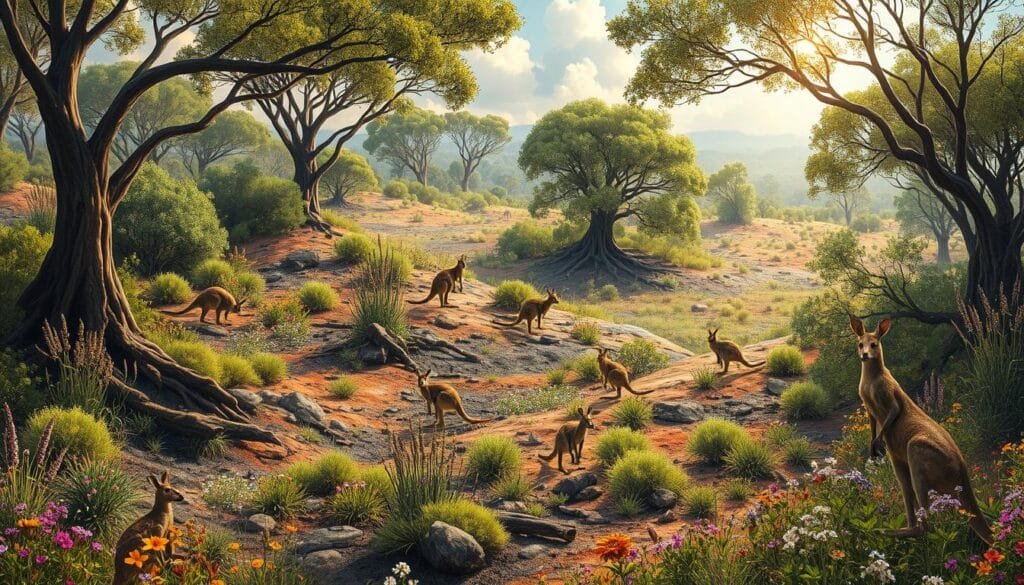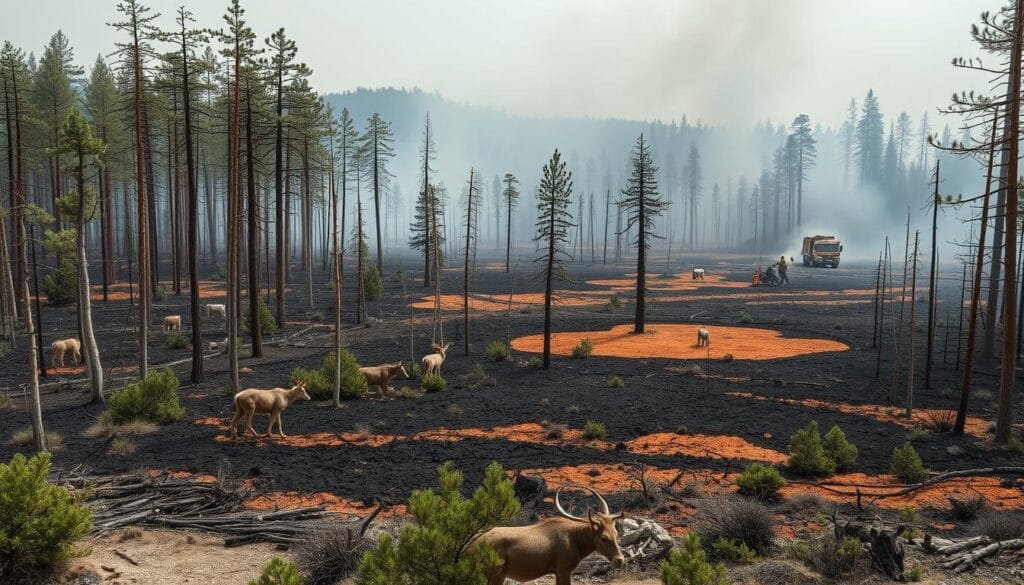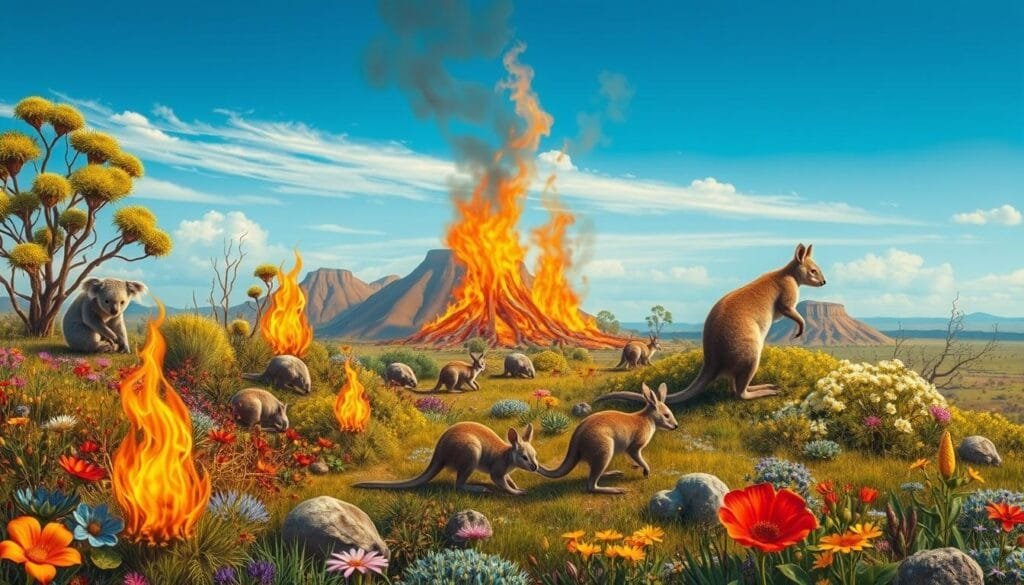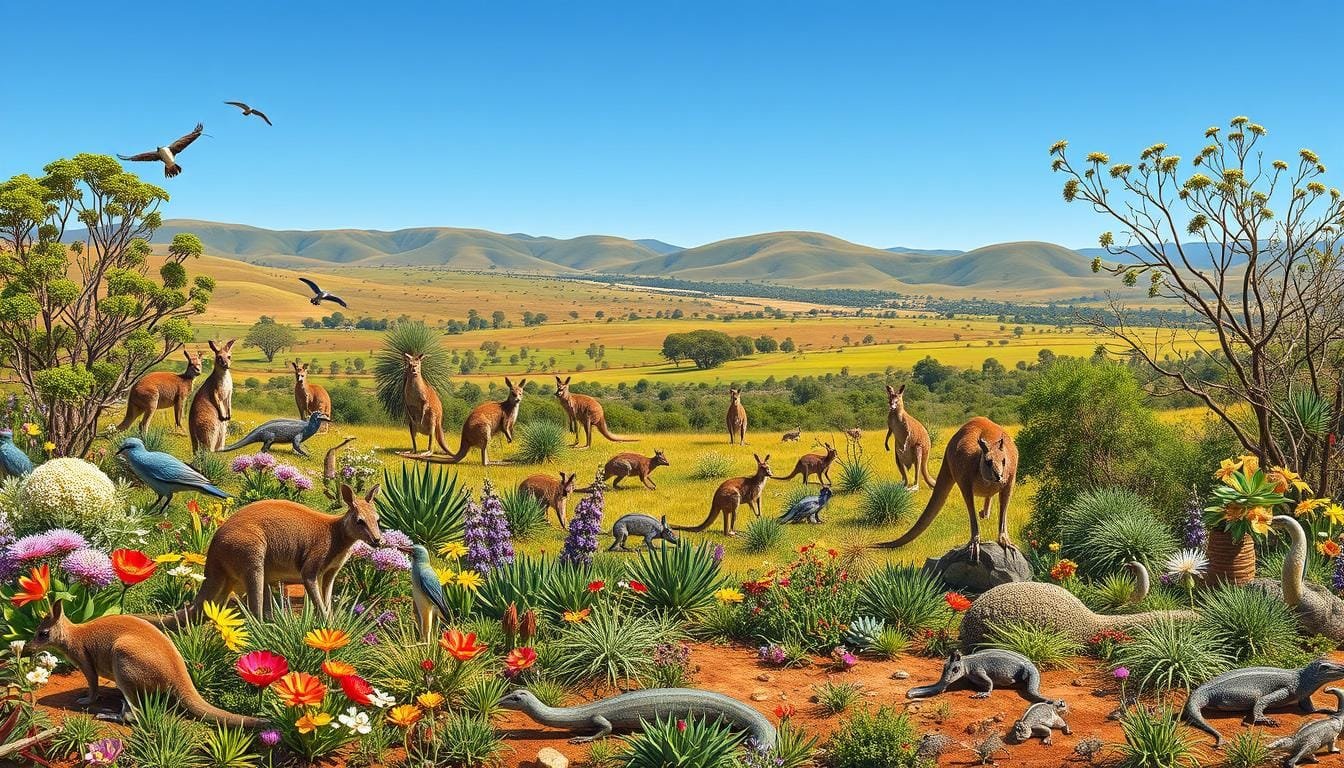Have you ever thought about the role of ancient fire management in today’s wildlife habitats?
Cultural burning is recognized more as wildfires grow and biodiversity lessens. Rooted in indigenous methods, it uses planned fires to boost ecosystems. It helps restore wildlife areas by controlling forest growth and promoting plant and animal diversity.
Research shows how cultural burning helps grow certain plants. In northern British Columbia, early spring fires boost wild onions, hazelnuts, and berries. These fires help ecosystems with insects, fungi, plants, and animals that are key for food and medicine.
Cultural burning is a powerful way to fix habitats, contrasting with recent uncontrollable fires. By using these ancient methods, we can help wildlife areas survive for the future.
Key Takeaways
- Cultural burning affects wildlife habitats by managing forests and promoting diverse ecosystems.
- This method aids in growing food and medicial plants, improving biodiversity.
- Traditional ecological knowledge has used cultural burns for thousands of years.
- Without fire, biodiversity drops and wildlife habitats can suffer.
- Indigenous fire practices can cut the risk of large, unmanageable wildfires.
Introduction to Cultural Burning
Cultural burning, or indigenous fire practices, are age-old methods. Indigenous communities have used them for thousands of years. They help manage ecosystems and keep biodiversity in places like the Sierra Nevada.
Definition and History
Cultural burning involves controlled, low-fire burns for ecological balance. These practices are over 60,000 years old. Indigenous tribes used these burns to manage forests and promote certain plants.
This method also helped control pests and stop big wildfires. However, in 1874, British Columbia’s Bush Fire Act banned these burns. This caused a loss of traditional fire knowledge among Indigenous peoples.
Significance for Indigenous Communities
For Indigenous groups, fire practices are more than managing land. They are key to their cultural heritage. These burns help bring back foods, medicines, and support wildlife habitats.
The BC Wildfire Service is now working with First Nations. They aim to bring these age-old methods into today’s fire management. This partnership is crucial.
“Cultural burning is not just a tool but a testament to the sustainable practices of Indigenous tribes, immensely contributing to ecological and cultural preservation.”
Cultural burning has been key in preserving the health and diversity of landscapes. It smartly combines ancient wisdom with modern fire management strategies.
How Cultural Burning Restores Ecological Balance
Cultural burning is key to restoring the balance of our ecosystems. It not only helps in managing forests but also increases species diversity. This is done through controlled burns and traditional fire methods. Let’s explore how it affects both forest density and diversity of species.
Managing Forest Density
Forest density management through cultural burning is crucial. Before the 20th century, this practice kept forest ecosystems in check, especially in California. It reduces forest biomass, cuts wildfire risk, and aids in ecological restoration. By doing so, it supports a variety of plant species, insects, and small mammals. This creates better habitats for wildlife.
Fire suppression policies have made our landscapes prone to worse wildfires. Cultural burning, however, can bring back ancient fire habits and improve nutrient cycles. This shift is key for healthier ecosystems. It encourages the return of native plants and helps the ecological balance.
Impact on Species Diversity
Cultural burning also greatly benefits species diversity. Sadly, we’ve lost about 62% of our native grasslands in North America. This loss has heavily affected species like grassland birds, which saw their numbers drop by 53% since 1970. Controlled burns help native species flourish by reducing invasive ones.
One interesting example is the Karner blue butterfly. It relies on wild lupine, which grows well in burned areas. This shows how some endangered species depend on controlled burns. Furthermore, birds like the upland sandpiper need these burns to keep their habitats clear of invasive trees.
The complex relationship between fire and ecological restoration is vital. The Nature Conservancy works to keep these traditional practices alive all over the world. Their work in places like Africa, Belize, and Australia shows the benefits of prescribed burns (source). By supporting cultural burning, we pave the way for more biodiversity and healthier ecosystems.
How Does Cultural Burning Enhance Wildlife Habitats
Cultural burning has deep roots in Indigenous traditions and is vital for wildlife habitat enhancement. It uses fire intentionally and controlled to manage ecosystems. This promotes biodiversity and helps prevent large wildfires.
The practice reduces canopy closure, opening up habitats for wildlife. This increases food resources and breeding grounds, making it easier for wildlife to thrive.

Cultural burns use traditional practices and local knowledge. This creates a balanced environment good for wildlife. These burns help maintain a fire ecology, supporting diverse species.
- Before the Gold Rush, California saw about 4.5 million acres burn yearly, naturally managing habitats.
- Now, private owners control 40% of California’s 33 million forest acres. They often work together on cultural burns.
- Indigenous communities have managed land with fire for thousands of years, proving the benefits of these methods.
In recent years, many groups have worked together on cultural burns. Students, tribal members, and state agencies are seeing the value of these practices. For example, the North Fork Mono Tribe has burned around 400 acres. This helped sourberry bushes grow back, showing how fire can bring plants back for traditional crafts.
In the Great Lakes region, Indigenous burns have boosted blueberry production. These practices promote ecosystems that are adapted to fire.
Learning from these long-standing practices is key to making land and fire management strategies better today.
Studies show cultural burning benefits the environment and lowers wildfire risks. A rejuvenated landscape with diverse plants provides great habitats for wildlife. This improves their food sources and shelter.
| Practice | Impact on Wildlife Habitat | Examples |
|---|---|---|
| Frequent Low-Intensity Fires | Enhance soil quality and promote fire-adapted ecosystems | Great Lakes region – blueberry production |
| Targeted Burning | Promotes ecological diversity and abundance | Eastern U.S. – oak and chestnut trees |
| Large Scheduled Burns | Direct large herds and improve hunting grounds | Northern Great Plains – bison |
Cultural burning manages vegetation and maintains wildlife habitats. It provides food and shelter for different species. This old practice meets today’s ecological needs, proving its importance in wildlife habitat enhancement.
Fire Suppression vs. Cultural Burning
Fire suppression and cultural burning have different goals for forest management. Fire suppression tried to stop wildfires at all costs. This caused forests to become too dense and prone to disease and pests. On the other hand, cultural burning uses low-intensity fires to keep forests healthy.
Historical Context
The US has seen big changes in fire management over time. The 1910 Big Burn destroyed millions of acres and showed the need for good fire strategies. Cool, moist weather from the 1940s to the 1980s helped reduce wildfire frequency.

But, the cool weather hid the truth about fire suppression’s impact. It made us think suppression worked well on its own. The truth is, it built up a lot of fuel, creating conditions ripe for severe wildfires when the weather changed.
Table comparing Fire Suppression Policies and Cultural Burning Practices:
| Aspect | Fire Suppression | Cultural Burning |
|---|---|---|
| Intensity | High, due to accumulated fuels | Low-intensity, controlled burns |
| Frequency | Infrequent due to suppression goals | Regular to manage and reduce buildup |
| Ecological Impact | Increased forest density, vulnerability to pests | Manages forest health, supports biodiversity |
| Wildfire Management | Focus on extinguishing fires | Preventive by reducing flammable material |
| Policy Shift | In place since early 20th century | Gaining recognition for effectiveness |
Cultural burning is now seen as an effective way to manage wildfires. Groups like the Indigenous Peoples Burning Network support it. The Bureau of Indian Affairs (BIA) is also starting to use cultural burning, combining it with modern fire science.
Benefits of Cultural Burning for Endangered Species
Cultural burning has shown great advantages for the recovery of endangered species. This practice is based on Indigenous wisdom. It not only brings habitats back to life but also has lasting benefits for many species.
Case Studies and Examples
The North Fork Mono Tribe provides a key example. Their cultural burning has restored vital habitats for endangered plants and animals. These actions show how cultural burning can help conservation efforts. They play a crucial role in saving and growing various species.

Indigenous Peoples cover only 5% of the world’s population. But, they protect nearly 85% of the global biodiversity. Groups like the Chipewyan Dene and the Tsa’tinne People use fire in unique ways. They meet the needs of local wildlife, proving a customized method is key to saving species.
Long-term Impact on Species Survival
Studies reveal Indigenous fire stewardship greatly boosts biodiversity. About 80% of studies notice changes in species numbers thanks to these practices. Research shows areas with cultural burning are healthier and have more species than those without it.
The Garry oak ecosystems have thrived for over 7,500 years through Indigenous fire stewardship. This ancient method brings diverse habitats. This is good for many plants and animals. It shows just how important conservation is for saving endangered species and fighting biodiversity loss.
The WALFA project also highlights the benefits of cultural burning. Started in 2005, it has greatly cut down emissions. This shows cultural burning is a lasting and effective way to protect nature. The benefits can last for years, making it a valuable strategy.
Cultural Burning Practices Around the World
Around the world, Indigenous groups use traditional burning applications to care for the land. These practices are adapted to local environments, creating balance between people and nature. From North America’s temperate rainforests to the Amazon’s tropics, cultural burns are vital for ecosystem health.
In Australia, Aboriginals have long used fire to boost biodiversity and reduce wildfire risks. These methods have halved northern Australia’s wildfires, cutting greenhouse gases by 40%. In the Amazon, Indigenous people use fires for farming without harming the forests.
In Northwestern British Columbia (B.C.), cultural burns happen in spring and fall, with snow still on the ground. This approach helps keep the ecosystem diverse and habitats varied. After years of fire suppression, there’s a push to bring back these Indigenous fire management practices.
Cultural burning has proven benefits for the environment. Studies show a 79% positive impact on biodiversity from such burns. These practices help everything from tiny microbes to big mammals and plants. They show how Indigenous burning is crucial for today’s conservation work.
| Region | Focus | Impact |
|---|---|---|
| Australia | Biodiversity & Wildfire Management | 50% reduction in destructive wildfires, 40% reduction in greenhouse gases |
| Amazon | Land Clearing & Farming | Preservation of forest integrity |
| Northwestern B.C. | Seasonal Burns | Enhanced biodiversity and habitat heterogeneity |
Today, merging international fire management with traditional approaches is key. Learning from Indigenous knowledge can lead to better, eco-friendly conservation. This is how we can support cultural and natural diversity together.
Conclusion
Cultural burning is a key ecological method that helps wildlife. It reduces extra materials that can fuel fires. This creates different habitats in areas, helping both land care and species variety. Studies from forests to grasslands show mixed effects on species.
These burns also boost outcomes like more hazelnut stems for basket making. The Karuk and Yurok tribes suggest burning every 3 to 5 years for best results. Yet, worries about smoke affect people’s views. But, teaching the public about its benefits is helping.
The future of cultural burning is bright with more research and teamwork. By joining Indigenous wisdom and modern science, we can better understand fire’s role. This leads to better biodiversity and land care worldwide.
FAQ
What is cultural burning and how does it benefit wildlife habitats?
Cultural burning is a method used by Indigenous communities to manage land. They use fire on purpose to help wildlife habitats. It restores balance in nature, boosts the variety of species, and leads to healthier ecosystems.
This practice ensures that plants, animals, and insects can thrive. They benefit from environments that have been shaped by controlled fires.
How do cultural burning practices impact forest management?
Cultural burning plays a key role in managing forests. It removes excess fuel and lowers the risk of big wildfires. This approach helps maintain a balance. It prevents forest areas from becoming too dense, which can cause destructive fires.
It also supports diverse plants and animals in the forest.
Why is cultural burning significant for Indigenous communities?
For Indigenous people, cultural burning is more than managing land; it’s part of their heritage. It comes from deep traditions and knowledge about nature. Fire is used to make the land better and more productive. It’s a different approach from how others might try to stop fires.
What are the long-term ecological benefits of cultural burning?
Research over time shows that cultural burns make ecosystems more resilient. Places with cultural burns have more species than those without. They help with species recovery, improve habitat quality, and boost overall biodiversity.
How does cultural burning compare to traditional fire suppression practices?
Traditional methods focus on stopping fires which can lead to more drastic wildfires. Cultural burning, however, uses mild fires to safely reduce the risk. More people are seeing how important cultural burning is for nature and fire prevention.
Can cultural burning help with the recovery of endangered species?
Yes, cultural burning can be a big help for endangered species. It improves where they live by using fire carefully and periodically. This creates better and more varied environments. These are crucial for helping at-risk species survive and grow.
What are some global examples of cultural burning practices?
Around the world, Indigenous communities use cultural burning in their own ways. This is seen in places like Australia, Africa, and North America. Their unique techniques contribute to the world’s biodiversity and conservation efforts.
What is the future of cultural burning in ecological conservation?
The outlook for using cultural burning in ecology is hopeful. More experts and policy makers are seeing its value. Working together, Indigenous knowledge and scientific research can make a big difference. They can help bring back ecological balance and encourage sustainable ways to look after our land.
